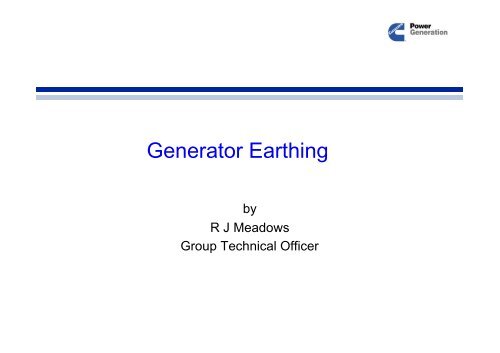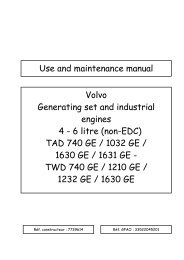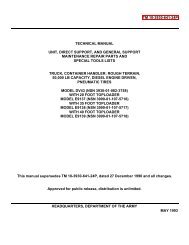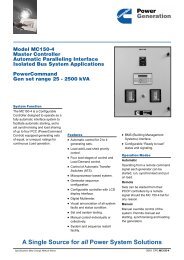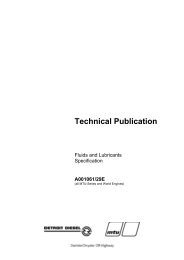Generator Earthing
Generator Earthing
Generator Earthing
You also want an ePaper? Increase the reach of your titles
YUMPU automatically turns print PDFs into web optimized ePapers that Google loves.
<strong>Generator</strong> <strong>Earthing</strong><br />
by<br />
R J Meadows<br />
Group Technical Officer
Why earth at all?<br />
Provides a reference for system voltages<br />
Avoids ‘floating’ voltages<br />
Prevents insulation stress<br />
Allows single earth faults to be detected<br />
Earth fault current is sensed<br />
Current magnitude used to trip protection devices<br />
EEBADS (Earthed equipotential bonding and automatic<br />
disconnection)<br />
Prevents ‘touch’ voltages on adjacent components<br />
Provides means of referencing 3-wire non-connected<br />
systems - e.g. during H.V. synchronising<br />
Legal requirement in UK distribution systems
Neutral not earthed<br />
Cannot detect a single earth fault by overcurrent unless a<br />
second earth fault occurs on another phase.<br />
11kV<br />
415V<br />
Red phase is earthed - no current flows.<br />
Neutral is raised to phase voltage above earth.<br />
Yellow and blue phases are at line voltage above<br />
earth, but remain at phase voltage to neutral.<br />
Fire risk if grounding contact is loose - arcing -<br />
due to cable capacitance currents to earth.<br />
Load<br />
Phase current<br />
Neutral current<br />
Earth path current<br />
FAULT!<br />
Shock hazard if person<br />
provides the earth<br />
connection - capacitance<br />
current.
Neutral earthed - EEBADS<br />
Fault current flows through the earth path - producing an<br />
effective L-N short circuit.<br />
R<br />
Y<br />
B<br />
11kV<br />
The overcurrent protection<br />
on the load circuit breaker<br />
will detect the fault current<br />
if the loop impedance is<br />
low enough to allow<br />
sufficient current to flow.<br />
415V<br />
Earth path<br />
impedance<br />
Load<br />
Phase current<br />
Neutral current<br />
Earth path current<br />
The loop impedance can be lowered by<br />
including more conductors in the earth path -<br />
e.g. cross bonding.<br />
I0
11kV<br />
Broken neutral<br />
A serious problem:<br />
240V<br />
240V<br />
Although the line voltages remain correct,<br />
the phase voltages (ph-n) vary widely.<br />
The red yellow and blue voltages to neutral<br />
will depend on the connected load quantity<br />
and balance, but could approach line<br />
voltage.<br />
240V<br />
415V<br />
415V 415V<br />
Load a<br />
240V 138V 240V 276V<br />
Z L<br />
2Z L<br />
B<br />
415<br />
368V<br />
Load b<br />
368<br />
240<br />
R<br />
138<br />
121.5<br />
N<br />
Displaced<br />
neutral -<br />
139V<br />
above true<br />
neutral<br />
276<br />
Y
Unrestricted earth fault protection<br />
e/f<br />
Load<br />
• Sensing CT is located in the neutral earth link.<br />
• Protection is by simple current sensing relay and will respond to any current<br />
flowing in the earth path.<br />
• The whole system is protected.<br />
• There is no selectivity - other than provided by the relays themselves.<br />
Phase current<br />
Earth path current<br />
CT current
Effect of multiple earthing - 1<br />
e/f<br />
Load<br />
Z L<br />
Phase current<br />
Neutral current<br />
Earth path current<br />
CT current<br />
EFFECT OF LEAVING<br />
ALTERNATOR NEUTRAL<br />
EARTH LINK IN PLACE.<br />
Nuisance tripping<br />
Neutral current has an<br />
alternative route, through<br />
the earth path, resulting in<br />
protection operation on load<br />
imbalance.<br />
• Unrestricted earth leakage protection is simple but is not without problems.<br />
• The key requirement for unrestricted earth leakage protection to be effective is that the<br />
neutral must be bonded to earth at one point only.<br />
• If this is not the case, protection will be unreliable, leading either to nuisance tripping, or<br />
failure to operate when required.
Gen. 1<br />
Gen. 2<br />
Effect of multiple earthing - 2<br />
e/f<br />
e/f<br />
Load<br />
Nuisance tripping<br />
Phase current<br />
Neutral current<br />
Earth path current<br />
CT current<br />
If the generators are not equally sized<br />
or are not sharing load equally, the<br />
parallel earth paths will provide an<br />
alternative route for the neutral current.<br />
If the earth fault protection is<br />
sufficiently sensitive it will trip, although<br />
there is no earth fault on the system.<br />
The protection may operate every time<br />
a generator is brought onto the<br />
system.<br />
The problem will be accentuated if<br />
there is significant 3rd harmonic<br />
present.<br />
Earth fault protection is desensitised<br />
by the parallel path...
Gen. 1<br />
Gen. 2<br />
Effect of multiple earthing - 3<br />
25 mA<br />
25 mA<br />
e/f<br />
e/f<br />
Load<br />
Phase current<br />
Earth leakage current = 50 mA<br />
Desensitisation<br />
Gen 1 earth path current<br />
Gen 2 earth path current<br />
CT current<br />
With 30 mA earth leakage protection on<br />
each generator and with each<br />
generator solidly earthed, the<br />
protection fails to operate with a<br />
leakage current of 50 mA as this is<br />
shared between the generator sets.<br />
The greater the number of sets<br />
connected - the worse the problem is.
Gen. 1<br />
Gen. 2<br />
Single point earthing<br />
50 mA<br />
Note that discrimination of earth leakage protection<br />
can normally only be achieved by using time delays.<br />
This is not compatible with personnel protection.<br />
Generally the generating set earth leakage protection<br />
should be delayed if possible.<br />
e/f<br />
Load<br />
Phase current<br />
Earth leakage current = 50 mA<br />
Gen 1 Earth path current<br />
Gen 2 Earth path current<br />
CT current<br />
The earth leakage protection on Gen. 1<br />
is arranged to intertrip both generators.<br />
There are no shared current paths and<br />
no circulating current therefore exists in<br />
the earth path.<br />
The set neutrals are interconnected<br />
and three pole circuit breakers are<br />
used.<br />
The earth leakage protection ignores<br />
any circulating current in the neutral<br />
paths.
Unrestricted earth fault protection<br />
Unrestricted earth fault protection - summary<br />
ADVANTAGES<br />
Simple to apply<br />
Provides protection for all earth faults on the generator, switchgear and system<br />
Can give good level of personnel protection throughout the system<br />
DISADVANTAGES<br />
Discrimination is difficult on current - time delays must be introduced<br />
Source will often trip at same time as downstream protection<br />
Blackout situation may be more dangerous than the original earth fault<br />
Difficult to apply to generators in parallel unless single point bonding scheme is<br />
adopted<br />
MAIN USE<br />
<strong>Generator</strong>s cannot be identically constructed<br />
Intertrip must be arranged<br />
Back-up high-set protection for main, submain and distribution board faults<br />
Sensitive protection (e.g. personnel) to be provided at final distribution stage
Restricted earth fault protection<br />
PROTECTION<br />
ZONE<br />
e/f<br />
Load<br />
NB: Neutral MUST NOT be earthed within the zone.<br />
Multiple earthing is permissible outside of the zone.<br />
Phase current<br />
Neutral current<br />
CT current<br />
NORMAL OPERATION<br />
Load current flows in phase and<br />
neutral conductors, inducing<br />
proportional currents in R + N<br />
CTs.<br />
Currents circulate in the CT loop<br />
and no spill current flows<br />
through the relay.
R.E.F. - fault outside zone<br />
PROTECTION<br />
ZONE<br />
e/f<br />
Zone is defined by position of neutral earth<br />
link relative to the CTs.<br />
Load<br />
Phase current<br />
Neutral current<br />
Earth path current<br />
CT current<br />
FAULT OUTSIDE OF ZONE<br />
Equal currents are induced in<br />
the R phase CT and the neutral<br />
CT. A circulating current is set<br />
up in the CT pilot wiring but no<br />
spill current enters the relay,<br />
which is insensitive to this fault.<br />
This type of protection relies on<br />
the integrity of the CT wiring and<br />
the accuracy of the CTs. Any<br />
variations in CT tolerances will<br />
result in instability to the through<br />
fault condition and will cause<br />
nuisance tripping.
R.E.F. - fault inside zone<br />
PROTECTION<br />
ZONE<br />
e/f<br />
Load<br />
Zone can be arranged to incorporate interconnecting<br />
power cables to remote switchgear if required.<br />
Note that no loads can be supplied between the windings<br />
and the CTs.<br />
Phase current<br />
Earth path current<br />
CT current<br />
FAULT INSIDE ZONE<br />
Fault current is induced in the N<br />
CT but not in any other CT. The<br />
induced current therefore flows<br />
through the relay.<br />
The setting of the relay can be<br />
low - governed only by the<br />
accuracy class of the CTs and<br />
relay and the degree of<br />
protection required, since<br />
restricted earth fault protection is<br />
not required to discriminate with<br />
downstream protection.
Gen. 1<br />
Gen. 2<br />
R.E.F. - sets in parallel - 1<br />
e/f<br />
e/f<br />
Load<br />
Phase current<br />
FAULT OUTSIDE OF ZONE<br />
Gen 1 Earth path current<br />
Although multiple earthing exists,<br />
protection is stable due to positioning of<br />
the neutral earth links.<br />
Equal currents are induced in both sets<br />
protection systems’ R/N CTs.<br />
No tripping occurs.<br />
Gen 2 Earth path current<br />
CT current
Gen. 1<br />
Gen. 2<br />
R.E.F. - sets in parallel - 2<br />
e/f<br />
e/f<br />
Load<br />
FAULT ON ONE SET<br />
Phase current<br />
Gen 1 Earth path current<br />
Gen 2 Earth path current<br />
CT current<br />
Both sets provide current into the fault.<br />
Set 1 current is induced in the N CT as<br />
before, but in this case, current from<br />
set 2 is induced in opposition and<br />
therefore aids tripping.<br />
Although set 2 contributes current, the<br />
fault is outside of the set 2 zone and no<br />
tripping therefore occurs.
Restricted earth fault protection<br />
Restricted earth fault protection - summary<br />
ADVANTAGES<br />
Not affected by faults outside of the protected zone (through faults).<br />
Easy to discriminate protection<br />
Less risk of nuisance tripping<br />
Can be set to low levels, reducing damage to alternator or cables in<br />
event of fault<br />
Can be set for instantaneous operation - reducing the possibility of touch<br />
voltages, etc.<br />
DISADVANTAGES<br />
Insensitive to phase - phase faults in alternator windings.<br />
Needs special CTs for best stability to through faults (Class X)<br />
Care needed when wiring to ensure that CTs are orientated and wired<br />
correctly.<br />
MAIN USE<br />
Zone protection for alternator and transformer windings
Differential protection - 1<br />
diff<br />
diff diff<br />
PROTECTION<br />
ZONE<br />
Typical relay setting 5% of rated current<br />
(reflected to CT secondary side).<br />
SINGLE PHASE<br />
LOAD<br />
MERZ - PRICE CIRCULATING CURRENT<br />
DIFFERENTIAL PROTECTION.<br />
Phase current<br />
Neutral current<br />
CT current<br />
A development of restricted earth fault protection that<br />
is able to cover both line-earth and line-line faults.<br />
Under fault-free conditions, equal currents are<br />
induced in the line-end and neutral-end CTs. No<br />
current flows in the sensing relay.<br />
The location of the neutral - earth link is not important.
i<br />
Differential protection - 2<br />
diff<br />
diff diff<br />
PROTECTION<br />
ZONE<br />
CT accuracy and correct wiring connections are<br />
of paramount importance. Class X CTs should<br />
be used and pilot resistors may be needed to<br />
balance the pilot impedances if, as is usual,<br />
the relay is mounted closer to one set of CTs<br />
than the other.<br />
THREE PHASE LOAD<br />
Phase currents<br />
CT current<br />
For three phase loads, both balanced and<br />
unbalanced, the line currents will always summate to<br />
zero, provided that there is no alternative path, e.g.<br />
earth fault.<br />
It is imperative that there is no parallel path for neutral<br />
current through the earth path if the earth point is<br />
inside zone, otherwise nuisance tripping will result in<br />
cases of unbalanced loading.
i<br />
Differential protection - 3<br />
diff<br />
diff diff<br />
PROTECTION<br />
ZONE<br />
LOA<br />
D<br />
Phase current<br />
Earth path current<br />
CT current<br />
SINGLE PHASE FAULT TO EARTH OUTSIDE OF<br />
ZONE<br />
Fault current is induced equally in both red phase CTs<br />
and circulates in the pilot loop.<br />
No current flows in the sensing relay circuits and the<br />
protection is thus insensitive to this type of fault.
Differential protection - 4<br />
diff<br />
diff diff<br />
PROTECTION<br />
ZONE<br />
For high voltage sets, the effects of an earth fault in the<br />
stator pack or terminal box may be severe. Differential<br />
protection, correctly installed will prevent the fault<br />
building up and will localise the damage.<br />
LOA<br />
D<br />
Phase current<br />
Earth path current<br />
CT current<br />
SINGLE PHASE FAULT TO EARTH INSIDE ZONE<br />
Fault current is induced in the Red phase neutral end CT<br />
but not in the corresponding Red phase line end CT.<br />
Load current is not shown and summates to zero in the<br />
loops<br />
Induced current circulates in the relay circuit and the<br />
protection operates, usually instantaneously. To ensure<br />
rapid collapse of fault current, the protection should be<br />
arranged to de-excite the alternator, since run-down<br />
times may be lengthy particularly on large machines.
Differential protection - 5<br />
diff<br />
diff diff<br />
PROTECTION<br />
ZONE<br />
Owing to the cost of installing differential protection, it is<br />
not normally applied to LV machines below 2MVA or HV<br />
machines below 1000kVA<br />
TWO PHASE FAULT INSIDE ZONE<br />
LOA<br />
D<br />
Phase currents<br />
Earth path current<br />
CT current<br />
Fault current is induced in the Red phase neutral end<br />
CT and in the Blue phase neutral end CT but not in<br />
the corresponding line end CTs.<br />
Induced current circulates in the red and blue relay<br />
circuits and the protection operates.
Differential protection - summary<br />
ADVANTAGES<br />
Sensitive<br />
Senses both line-line and line earth faults<br />
Zone protection eliminates discrimination problems<br />
Ability to annunciate which phase(s) have faulted<br />
DISADVANTAGES<br />
Relatively expensive<br />
Will often require balancing resistors in CT pilots, which are bulky<br />
Complex to connect - particularly if star-delta transformers are involved<br />
or if a generator and unit transformer are to be protected (biased<br />
differential)<br />
Prone to connection errors, which can be difficult to find<br />
Requires special CTs (Class X)<br />
MAIN USES<br />
Earth and interturn fault protection of high voltage or large low voltage<br />
alternators and transformers
Back-up earth fault<br />
Used to protect neutral earthing resistors or to provide<br />
back-up in event of protection failure.<br />
NER<br />
e/f<br />
BACKUP EARTH<br />
FAULT<br />
•Resistor is normally sized to pass full rated<br />
current (generally the full load current of the<br />
largest set on the system) for either 10 or 30<br />
seconds.<br />
•The backup protection should be set to trip the<br />
system if the rating of the resistor is exceeded.<br />
•Note that the presence of an NER does not<br />
alter the configuration of the protection, but<br />
does alter the settings and reduces the<br />
discrimination that can be achieved further<br />
down the system.<br />
•Backup earth fault is another form of<br />
unrestricted earth fault and must be accounted<br />
in the discrimination scheme.
<strong>Earthing</strong> the generator - 1<br />
Single generator<br />
LV set must have neutral earthed<br />
May be possible to interconnect with supply utility company<br />
earth<br />
Should have own earth system as well - in case of loss of<br />
supply system earth (e.g. fractured cable)<br />
Maximum recommended impedance 20<br />
Actual value will depend on the circuit breaker protection settings<br />
If CB setting range cannot be achieved - earth leakage protection<br />
e.g. If earth resistance is 1 maximum current on LV set is 240A, with 20 ,<br />
12A. - not sufficient for any set main circuit protection<br />
Using 300mA earth leakage protection allows a maximum earth impedance of<br />
800 <br />
Using 30mA protection allows a maximum earth impedance of 8000 ,<br />
although this would normally be excessively high.<br />
All extraneous conductive parts must be bonded together and earthed
<strong>Earthing</strong> the generator - 2<br />
Parallel generators<br />
LV system must have neutral earthed - not necessarily<br />
individual sets<br />
Parallel neutral must be rated for 3rd Harmonic currents<br />
between sets as well as system.<br />
Sets should not use earth path for neutral interconnection<br />
Risk of 3rd harmonic currents disturbing telecommunications<br />
Set and mains neutral earth should not be paralleled when in<br />
parallel with mains<br />
May result in loss of mains through tripping of S.E.F. protection<br />
Will desensitise overall earth fault protection if present<br />
Care should be taken not to inadvertently parallel neutral<br />
through the earth path on incompatible sets.
60<br />
40<br />
20<br />
0<br />
-20<br />
-40<br />
-60<br />
Understanding 3rd Harmonics<br />
Effect of 10A third harmonic on neutral current<br />
Red H1<br />
Red H3<br />
Yellow H3<br />
Blue H3<br />
Neutral<br />
3rd harmonics are a<br />
distortion of the load<br />
current waveform -<br />
effectively other<br />
currents at higher<br />
frequency (150Hz in<br />
this case), are added<br />
to the fundamental<br />
(H1).<br />
They are caused<br />
mainly by switched<br />
mode power supplies<br />
(PCs) and discharge<br />
lighting<br />
These currents add in<br />
the neutral - giving<br />
rise to possibility of<br />
neutral current<br />
exceeding line<br />
current.
R<br />
Y<br />
B<br />
Avoiding 3rd harmonic problems<br />
11kV 415V<br />
Third harmonic circulating current will cause<br />
waveform distortion and will cause an effective<br />
variance between the average value of the<br />
waveform (most AVRs) and the RMS (most<br />
meters).<br />
Voltage regulator will appear inaccurate.<br />
X<br />
X<br />
Avoid connecting two star<br />
windings together:<br />
X<br />
<strong>Generator</strong> should be<br />
connected to a delta wound<br />
step up transformer LV<br />
winding<br />
HV step down transformer<br />
should have delta HV<br />
winding + star LV<br />
If you have to connect two<br />
star windings together:<br />
Try to avoid connecting the<br />
neutral as well as the phase<br />
conductors. Take the<br />
neutral from the source.
Summary<br />
In this presentation we have discussed:<br />
The importance of a neutral connection<br />
What happens if the neutral becomes disconnected<br />
Unrestricted earth fault protection<br />
Restricted earth fault protection<br />
Differential protection<br />
Back-up earth fault protection<br />
Waveform distortion<br />
Remember - this presentation is not exhaustive. Individual<br />
systems must be evaluated on their merit.<br />
The supplier of the equipment, as a professional, and the<br />
customer are jointly responsible for ensuring the safety of the<br />
system and the people who use it.


